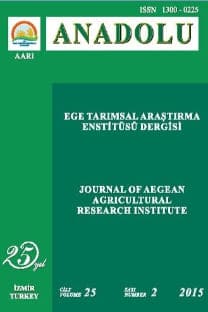Anadolu’da Yetişen Gundelia (Asteraceae) Taksonlarının ITS Filogenisi ve Moleküler Tarihlendirilmesi
ITS Phylogeny and Molecular Dating of some Gundelia (Asteraceae) of Anatolia
___
- Anonymous. 2016. Molecular evolution, phylogenetics and epidemiology. http://tree.bio.ed.ac.uk/software/figtree.
- Avetisian, V. E. 1995. Gundelieae. In: A. L. Takhtajan (Ed.). Flora Armenii 9. Koeltz Scientific Books, Havlíčkův Brod. pp. 212-216.
- Drummond, A. J., M. A. Suchard, D. Xie, & A. Rambaut. 2012. Bayesian Phylogenetics with BEAUti and the BEAST 1.7. MolecularBiology and Evolution 29: 1969-1973.
- Feinbrun-Dothan, N. 1978. Flora Palaestina, 3. The Israel Academy of Sciences and Humanities, Jerusalem, 481 pp.
- Firat, M. 2016. Four new species of Gundelia L. (Asteraceae) from Anatolia: G. komagenensis, G. colemerikensis, G. cilicica and G. anatolica. Vameda Ofset Press, Van, 32 pp.
- Firat, M. 2017a. Gundelia rosea (Asteraceae), a new record for the Flora of Turkey with contributions to its systematics. Acta Biologica Turcica 30 (2): 31‒35.
- Firat, M. 2017b. Gundelia mesopotamica (Asteraceae), a new lactiferous species from Mardin (Turkey). Acta Biologica Turcica 30 (3): 64-69.
- Hall T. A. 1999. BioEdit: a user-friendly biological sequence alignment editor and analysis program for Windows 95/98/NT. Nucleic Acids Symp., Ser. 41: 95- 98.
- Karis P. O., P. Eldenäs, and M. Källersjö. 2001. New evidence for systematic position of Gundelia L. With notes on delimitation of Arctoteae (Asteraceae). Taxon, 50: 105-114.
- Kupicha, F. K. 1875. Gundelia. In: P. H. Davis (Ed.). Flora of Turkey 5. University Press, Edinburgh, pp. 325-326.
- Nikitin, V. V. 1960. Gundelia L. In: B. K. Schischkin (Ed.). Flora Turkmenii 7. Akademiia nauk Turkmenskoĭ SSR, Institut Botaniki, Ashkhabad, p. 141.
- Rambaut, A., and A. J. Drummond. 2007. Tracer, version 1.4. Available from http:// beast.bio.ed.ac.uk/Tracer.
- Rechinger, K. H. 1989. Gundelia. In: K. H. Rechinger (Ed.). Flora Iranica 164. Akademische Druck- und Verlagsanstalt, Graz, pp. 107-109.
- Sofieva, R. M. 1961. Gundelia L. In: I. I. Karjagin (Ed.). Flora Azerbajdžana 8. Azerbaijan National Academy of Sciences Press, Baku, pp. 347-348.
- Thiers, B. 2016. Index Herbariorum: A Global Directory of Public Herbaria and Associated Staff. New York Botanical Garden’s Virtual Herbarium. http://sweetgum.nybg.org/science/ih/
- Tremetsberger, K., Gemeinholzer, B., Zetzsche, H., Blackmore, S., Kilian, N., & Talavera, S. (2013). Divergence time estimation in Cichorieae (Asteraceae) using a fossil-calibrated relaxed molecular clock. Organisms Diversity and Evolution, 13 (1): 1-13.
- Vasilchenko, I. T. 1961. Gundelia L. In: V. L. Komarov (Ed.). Flora SSSR, 26. Nauka Publishers, Moscow & Leningrad, p. 862.
- Vitek, E., G. Fayvush, K. Tamanyan, and B. Gemeinholzer. 2010. New taxa of Gundelia (Compositae) in Armenia. Annalen des Naturhistorischen Museums Wien, Serie B 111: 85-99.
- Warwick, S. I., Al-Shehbaz, I. A., Sauder, C. A., Murray, D. F., Mummenhoff, K. 2004. Phylogeny of Smelowskia and related genera (Brassicaceae) based on nuclear ITS DNA and chloroplast trnL intron DNA sequences. Annals of the Missouri Botanical Garden 91: 99–123.
- White, T. J. T, Bruns, S. L., Taylor, J. W. 1990. Amplification and direct sequencing of fungal ribosomal RNA genes for phylogenetics. In: Innis, M. A., Gelfand, D. H., Sninsky, J. J. and White, T. J. (Ed.). PCR Protocols: A Guide to Methods and Applications, Academic Press, Inc., New York. pp. 315–322.
- ISSN: 1300-0225
- Yayın Aralığı: 2
- Başlangıç: 1991
- Yayıncı: Ege Tarımsal Araştırma Enstitüsü
Economic and Socio-Cultural Importance of Edible Wild Species
Nutritional Properties of some Wild Edible Plant Species in Turkey
Nurcan A GUZELSOY, Ozgul UCURUM, Emre TOKAT, Ayfer TAN, Saadet TUĞRUL AY, Kürşad ÖZBEK
Nese ADANACIOGLU, Ayfer TAN, Sevinc KARABAK, Nurcan GUZELSOY, Firat AYAS, Lerzan AYKAS, Tefik TAYLAN
Ayfer TAN, Neşe ADANACIOĞLU, Sevinç KARABAK, Nurcan AYSAR, Ahmet Şemsettin TAN, Lerzan AYKAS
Halophytes as a Potential Food Source
GÜL NİLHAN TUĞ, AHMET EMRE YAPRAK
Strategy of Conservation and Protection of Wild Edible Plants Diversity in Burkina Faso
Mamounata BELEM, Moumouni NABALOUM, Josephine YAMEOGO
Alev KIR, Ayfer TAN, Nese ADANACIOGLU, Sevinc KARABAK, Nurcan AYSAR GUZELSOY
Mehari WELDEKIROS, Emiru BIRHANE, Woldegebrial ZEWELD, Sarah TEWELDEBIRHAN
Adel M ELMAGHABI, Salem HAMMUD, Elmunder ABUGNIA
